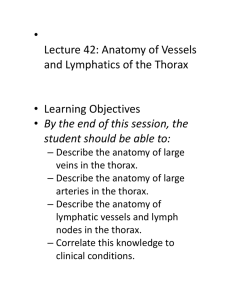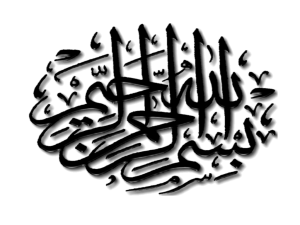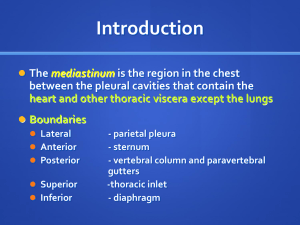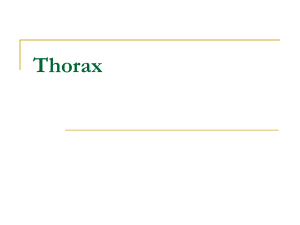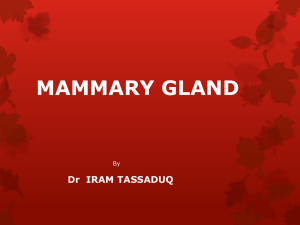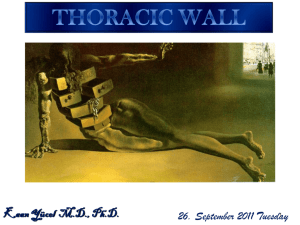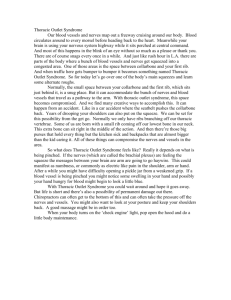Mediastinum Anatomy: Anterior & Posterior Presentation
advertisement
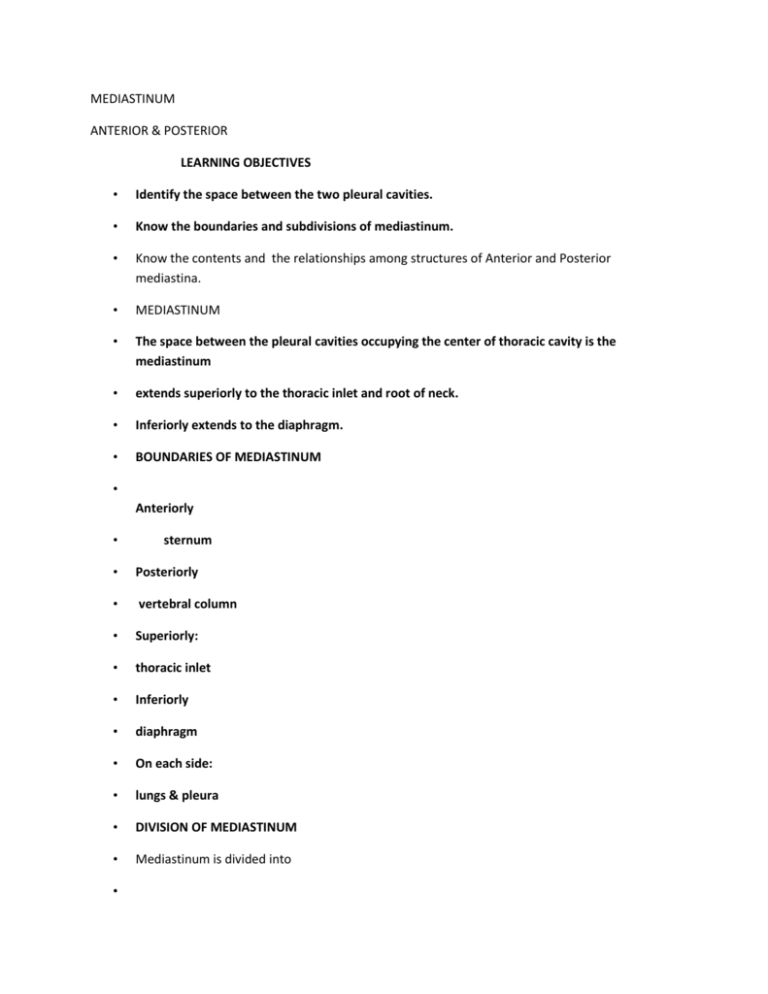
MEDIASTINUM ANTERIOR & POSTERIOR LEARNING OBJECTIVES • Identify the space between the two pleural cavities. • Know the boundaries and subdivisions of mediastinum. • Know the contents and the relationships among structures of Anterior and Posterior mediastina. • MEDIASTINUM • The space between the pleural cavities occupying the center of thoracic cavity is the mediastinum • extends superiorly to the thoracic inlet and root of neck. • Inferiorly extends to the diaphragm. • BOUNDARIES OF MEDIASTINUM • Anteriorly • sternum • Posteriorly • vertebral column • Superiorly: • thoracic inlet • Inferiorly • diaphragm • On each side: • lungs & pleura • DIVISION OF MEDIASTINUM • Mediastinum is divided into • • superior and • inferior mediastinum • by imaginary line passing • anteriorly through sternal • angle to the lower border of • body of fourth thoracic • vertebra posteriorly. • INFERIOR MEDIASTINUM • ANTERIOR MEDIASTINUM • Lies In front Of The Pericardium • MIDDLE MEDIASTINUM • Contains Heart And Pericardium • POSTERIOR MEDIASTINUM • Lies Behind The Pericardium • INFERIOR MEDIASTINUM • ANTERIOR MEDIASTINUM • Location • posterior to body of sternum and attached costal cartilages, anterior to heart and pericardium • Contents • Fat • Remnants of thymus gland • Anterior mediastinal • • lymph nodes THYMUS • The remains of the thymus embedded in fatty connective tissue immediately posterior to manubrium sterni. • The organ reaches its greatest size relative to the remainder of the body at birth. • It continues to enlarge until puberty, when it gradually starts to atrophy, and very little is present in old age. • It receives its arterial supply from the internal thoracic arteries. • INFERIOR MEDIASTINUM • POSTERIOR MEDIASTINUM • • Location: posterior to heart and pericardium, • • anterior to vertebrae T5-T12 • Contents: • Esophagus • Vagi and sphlanchnic nerves • Thoracic aorta and its branches • Azygos system of veins • Thoracic duct • Thoracic sympathetic trunk • Posterior mediastinal lymph nodes • RELATIONS OF ESOPHAGUS • Anteriorly • Trachea • Bifurcation of trachea • Left principal bronchus • Left recurrent n. • Right pulmonary a. • Anterior esophageal plexus • Pericardium • Left atrium • Diaphragm • Posteriorly • Posterior esophageal plexus • Thoracic aorta • Thoracic duct • Azygos v. • Hemiazygos v. • Accessory hemiazygos v. • Right posterior intercostal v. • RELATIONS OF ESOPHAGUS • Left • Left common carotid a. • Left subclavian a. • Aortic arch • Thoracic aorta • Superior part of thoracic duct • Right • Arch of azygos v. • BLOOD SUPPLY OF ESOPHAGUS • Bronchial artery. • Thoracic aorta. • Left gastric artery. • Left inferior phrenic artery. • INNERVATION OF ESOPHAGUS • Esophageal plexus: • Continuation of posterior pulmonary plexus. • Formed by right and left vagus nerves: • Right vagus nerve posterior vagus nerve. • Left vagus nerve anterior vagus nerve. • Upper third: • Voluntary muscle. • Innervated by recurrent laryngeal nerve. • Lower two-thirds: • Involuntary muscle. • Innervated by vagus and sympathetic chain. • DESCENDING THORACIC AORTA • Lies within posterior mediastinum. • Begins at level of sternal angle. • Ends in front of thoracic vertebra 12 • Continuous with abdominal aorta. • RELATIONS OF THORACIC AORTA • Anteriorly • Left root of lung • Pericardium • Esophagus • Posterior • Hemiazygos v. • Accessory hemiazygos v. • Right • Azygos v. • Thoracic duct • Left • • mediastinal pleura THORACIC DUCT • Arises from cisterna chyl at union of right and left lumbar trunks. • Begins on front of vertebral body T12 or L1. • Runs up through the thorax along the front of the vertebral column. • At first it lies to the right of midline. • It moves over to the left side when it reaches level T-5. • Receives most of lymph from body below diaphragm. • Drains left side of thoracic cavity and part of right. • Receives lymph from left internal jugular lymph trunk. • Receives lymph from left subclavian lymph trunk. • Empties into venous system at junction of: • Left internal jugular vein. • Left subclavian vein. • RIGHT lymphatic DUCT • Drains upper right thoracic cavity, right upper extremity, and right side of head and neck. • Empties into venous system • • at junction of: Right internal jugular vein. • Right subclavian vein. • THORACIC SYMPATHETIC CHAIN • Lies against neck of ribs and costovertebral junctions. • 12 thoracic ganglia pairs • First one often fused with inferior cervical ganglion • Referred to as stellate ganglion collectively • Cervical ganglia: • Superior. • Middle. • Inferior. • DESCENDING THORACIC AORTA • BRANCHES: • Paired intercostal arteries. • Paired subcostal arteries. • Two or more bronchial arteries. • Two to five esophageal arteries. • AZYGOUS VEIN • Forms in abdomen • From right subcostal and ascending lumbar veins. • Drains all right posterior intercostal veins except first. • Also receives blood from the bronchial and esophageal veins. • . HEMIAZYGOUS VEIN • Forms in abdomen • From left subcostal and left ascending lumbar veins. • Receives four posterior intercostal veins. • Crosses over thoracic vertebrae at T8 level. • Empties into azygos vein. • ACESSORY HEMIAZYGOUS VEINS • Drains intercostal spaces 4-7(8) on left side. • Crosses over thoracic vertebrae at level T7. • Empties into azygos vein • Note: Intercostal space 1 is drained by the supreme intercostal vein emptying into the brachiocephalic vein. • AZYGOUS, HEMIAZYGOUS AND ACESSORY HEMIAZYGOUS VEINS • LYMPH NODES OF POSTERIOR MEDIASTINUM • Posterior Mediastinal Lymph Nodes • receives lymph from esophagus, • posterior aspect of the pericardium • diaphragm and • middle posterior ICS
